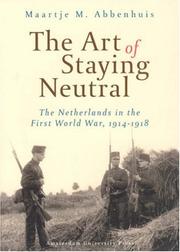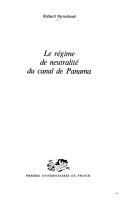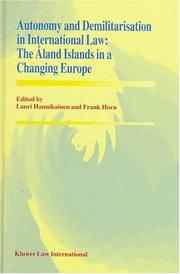| Listing 1 - 10 of 14 | << page >> |
Sort by
|
Book
Year: 1918 Publisher: New York George H. Doran Company
Abstract | Keywords | Export | Availability | Bookmark
 Loading...
Loading...Choose an application
- Reference Manager
- EndNote
- RefWorks (Direct export to RefWorks)
Book
ISBN: 3036568042 3036568050 Year: 2023 Publisher: Basel : MDPI,
Abstract | Keywords | Export | Availability | Bookmark
 Loading...
Loading...Choose an application
- Reference Manager
- EndNote
- RefWorks (Direct export to RefWorks)
Energy systems have played an essential role in the history of human civilization. As our civilization evolves, energy systems are expected to adapt to the environment and desire of people for more sustainable development whilst meeting the ever-increasing energy demand of society. To address global warming and its threats to sustainable development to multiple ends, major economies around the world have announced low-carbon, carbon-neutral, or negative-carbon development targets. To meet these goals, the energy systems as we know them today need to undergo substantial structural changes in terms of the way primary energy is extracted from nature, converted to secondary energy, transmitted from conversion sites to end use, and shifted between time slots to coordinate supply and demand. The share of renewable and fossil energy in the overall energy portfolio could experience unprecedented structural change of a kind not witnessed since industrialization. To cope with this harsh transition, energy systems should be planned, designed, retrofitted, and operated in a revolutionary manner.This reprint aims to present the most recent advances in energy systems analysis towards low/zero/negative carbon emission targets via integration amongst different primary energy supplies, between multiple energy supplies and demands, across geographically separated regions, and over different time scales from seconds to seasons.
Neutrality. --- Neutralism --- Neutrality --- International relations --- Buffer states --- Intervention (International law) --- Isolationism --- Nonalignment --- Prize law --- Region of war --- Unneutral service --- War, Maritime (International law) --- War (International law) --- Law and legislation

ISBN: 9789053568187 9053568182 9786610958221 9048503930 1280958227 1429454164 9781429454162 9789048503933 9781280958229 661095822X Year: 2006 Publisher: Amsterdam Amsterdam University Press
Abstract | Keywords | Export | Availability | Bookmark
 Loading...
Loading...Choose an application
- Reference Manager
- EndNote
- RefWorks (Direct export to RefWorks)
The Art of Staying Neutral offers a fascinating insight into the problems and challenges associated with neutrality in an age of 'total war'. It explains how the Netherlands upheld and protected its non-belligerency during the First World War despite constant interference from its warring neighbours. Staying neutral was an artform that the Dutch managed to master through clever diplomacy, conscientious adherence to international laws, comprehensive mobilisation of its armed forces, regular patrols of its territorial boundaries, careful policing of its citizens, and a decisive measure of good fortune. The Art of Staying Neutral makes important contributions to the study of neutrality and the domestic history of the Netherlands in this seminal world event.
History of the Netherlands --- anno 1910-1919 --- Neutrality. --- World War, 1914-1918. --- World War, 1914-1918 --- Neutrality --- History & Archaeology --- History - General --- History --- Netherlands --- Neutralism --- Law and legislation --- International relations --- Buffer states --- Intervention (International law) --- Isolationism --- Nonalignment --- Prize law --- Region of war --- Unneutral service --- War, Maritime (International law) --- War (International law) --- geschiedenis --- history, geography, and auxiliary disciplines
Book
ISBN: 3845284757 3848742063 Year: 2018 Publisher: Nomos Verlagsgesellschaft mbH & Co. KG
Abstract | Keywords | Export | Availability | Bookmark
 Loading...
Loading...Choose an application
- Reference Manager
- EndNote
- RefWorks (Direct export to RefWorks)
"Permanent neutrality – a chance or more a burden for a young nation? In 1955 Austria gained back its sovereignty with signing the State Treaty of Vienna. Before that, Austria took over the obligation of becoming a permanent neutral state in the Moscow Memorandum. This study focuses on the efforts of Austrian politics, science and people to position the country in Europe and in the United Nations within the framework of the Cold War. The analysis shows how the semantics and the functions of the permanent neutrality have changed from 1955 to 1989 and how the Austrian citizens have contemplated the neutrality of their state. Moreover the study explores the interdependency between political developments and scientific research and, as a consequence of that, the role neutrality played on a political level. The examination reveals the various definitions of neutrality and points out the significance it still has today. "
Neutrality. --- Neutralism --- Neutrality --- International relations --- Buffer states --- Intervention (International law) --- Isolationism --- Nonalignment --- Prize law --- Region of war --- Unneutral service --- War, Maritime (International law) --- War (International law) --- Law and legislation --- International law --- History. --- Study and teaching --- Law of nations --- Nations, Law of --- Public international law --- Law --- Kalter Krieg --- Neutralität --- Österreich --- Völkerrechtsgeschichte --- Völkerrechtslehre
Book
ISBN: 9517690851 Year: 1999 Publisher: Berlin Helsinki Paris Institut für Europäische Politik The Finnish Institute of International Affairs WEU Istitute for Security Studies
Abstract | Keywords | Export | Availability | Bookmark
 Loading...
Loading...Choose an application
- Reference Manager
- EndNote
- RefWorks (Direct export to RefWorks)
EUROPE--NATIONAL SECURITY --- EU--CFSP --- EUROPE--NATIONAL SECURITY--SWEDEN --- EUROPE--NATIONAL SECURITY--FINLAND --- NONALIGNMENT --- ESDI --- National security --- Neutrality --- Security, International --- Collective security --- International security --- International relations --- Disarmament --- International organization --- Peace --- Neutralism --- Buffer states --- Intervention (International law) --- Isolationism --- Nonalignment --- Prize law --- Region of war --- Unneutral service --- War, Maritime (International law) --- War (International law) --- Law and legislation --- North Atlantic Treaty Organization --- North Atlantic treaty organisation --- NAVO --- OTAN --- Military policy. --- Europe, Northern --- Europe --- Northern Europe --- Defenses. --- NATO
Book
ISBN: 022630096X 022630079X 022630082X Year: 2018 Publisher: Chicago ; London : The University of Chicago Press,
Abstract | Keywords | Export | Availability | Bookmark
 Loading...
Loading...Choose an application
- Reference Manager
- EndNote
- RefWorks (Direct export to RefWorks)
Building the American Republic combines centuries of perspectives and voices into a fluid narrative of the United States. Throughout their respective volumes, Harry L. Watson and Jane Dailey take care to integrate varied scholarly perspectives and work to engage a diverse readership by addressing what we all share: membership in a democratic republic, with joint claims on its self-governing tradition. It will be one of the first peer-reviewed American history textbooks to be offered completely free in digital form. Visit buildingtheamericanrepublic.org for more information. The American nation came apart in a violent civil war less than a century after ratification of the Constitution. When it was reborn five years later, both the republic and its Constitution were transformed. Volume 2 opens as America struggles to regain its footing, reeling from a presidential assassination and facing massive economic growth, rapid demographic change, and combustive politics. The next century and a half saw the United States enter and then dominate the world stage, even as the country struggled to live up to its own principles of liberty, justice, and equality. Volume 2 of Building the American Republic takes the reader from the Gilded Age to the present, as the nation becomes an imperial power, rethinks the Constitution, witnesses the rise of powerful new technologies, and navigates an always-shifting cultural landscape shaped by an increasingly diverse population. Ending with the 2016 election, this volume provides a needed reminder that the future of the American republic depends on a citizenry that understands-and can learn from-its history.
HISTORY / General. --- United States --- History. --- peer reviewed, American History, narrative history, free, open access, introduction, manifest destiny, labor wars, labor unions, jim crow, American empire, Dollar Diplomacy, Progressive Era, WWI, Women's Rights, the depression, the new deal, isolationism, wwii, the cold war, red scare, civil rights movment, Lyndon B. Johnson, Vietnam, the silent majority, political economy, Ronald Reagan, Gulf War, 9-11, voting rights, campaign finance reform, the great recession, fast moving, compelling, scholarship, engaging, inclusive, stimulating, fundamental themes, demographic.

ISBN: 071008143X 9780710081438 Year: 1975 Publisher: London: Routledge,
Abstract | Keywords | Export | Availability | Bookmark
 Loading...
Loading...Choose an application
- Reference Manager
- EndNote
- RefWorks (Direct export to RefWorks)
International relations. Foreign policy --- Communist strategy --- Neutrality --- Peace --- War and socialism --- Stratégie communiste --- Neutralité --- Paix --- Guerre et socialisme --- War and socialism. --- Communist strategy. --- Neutrality. --- Peace. --- 812 Ideologie --- 855 Oorlogsvoering --- 861 Vredesbeweging --- 884.1 Oost-Europa --- Stratégie communiste --- Neutralité --- Socialism and war --- Socialism --- Coexistence, Peaceful --- Peaceful coexistence --- International relations --- Disarmament --- Peace-building --- Security, International --- War --- Strategy, Communist --- Communism --- World politics --- Neutralism --- Buffer states --- Intervention (International law) --- Isolationism --- Nonalignment --- Prize law --- Region of war --- Unneutral service --- War, Maritime (International law) --- War (International law) --- Law and legislation

ISBN: 2130382622 294054946X 9782130382621 Year: 1983 Publisher: Graduate Institute Publications
Abstract | Keywords | Export | Availability | Bookmark
 Loading...
Loading...Choose an application
- Reference Manager
- EndNote
- RefWorks (Direct export to RefWorks)
De toutes les voies de communication maritimes, le canal de Panama est sans doute celle ayant suscité l'intérêt le plus soutenu des chercheurs, et ce pour de multiples raisons : rivalités des puissances maritimes, au siècle dernier, pour obtenir la mainmise sur le futur canal ; péripéties ayant accompagné le creusement du canal ; importance géographique, économique et stratégique de la voie d'eau ; souci constant des États-Unis d'en contrôler les accès. Récemment, de nouveaux accords furent conclus entre le riverain et les États-Unis, accords censés frapper du sceau de la pérennité juridique le régime d'utilisation du canal. Curieusement, le canal fut toujours déclaré neutre ou neutralisé, alors même que les États-Unis l'assimilaient à une part de leur ligne côtière et en interdisaient l'accès aux navires ennemis en temps de guerre : que cachait – et cache encore – cet abus de langage ? Partant de cette question apparemment anodine, Richard Perruchoud situe l'origine de la neutralité du canal dans l'histoire des relations internationales du xixe siècle. Il analyse ensuite le régime de neutralité qualifiant le régime d'utilisation du canal tant sous l'empire des anciens traités qu'en vertu de ceux récemment conclus, nous conduisant ainsi à travers les arcanes de maintes questions fondamentales : liberté de transit, droits de péage, protection et défense du canal, droit d'intervention des États-Unis, hypothétique canal à niveau, garantie du régime. Par la rigueur de l'analyse et le pragmatisme des solutions avancées, le présent ouvrage est appelé à devenir un guide indispensable à la compréhension des problèmes souvent complexes que pose le régime de neutralité du canal de Panama. Diplômé d'études juridiques supérieures (1975) et docteur en droit de l'Université de Genève (1978), Richard Perruchoud fut Visiting Scholar à la Harvard Law School, puis chargé de recherches à l'Institut universitaire de hautes études internationales à Genève. Il est actuellement…
Canal de Panamã (Panamã) --- Panamã --- Navigation --- Droit. --- Neutralité. --- Relations extérieures --- Neutrality --- International Law --- Law, Politics & Government --- International Law - General --- #SBIB:328H32 --- Instellingen en beleid: Midden en Latijns-Amerika --- Canal de Panamá (Panamá) --- Panamá --- Neutralité. --- Relations extérieures --- Neutralism --- Law and legislation --- International relations --- Buffer states --- Intervention (International law) --- Isolationism --- Nonalignment --- Prize law --- Region of war --- Unneutral service --- War, Maritime (International law) --- War (International law) --- Neutrality - Panama - Canal Zone --- diplomatie --- gouvernance --- cours d'eau --- coopération internationale --- politique étrangère --- canal de Panama --- conflits sécurité et consolidation de la paix --- commerce international --- histoire du droit --- guerre --- sécurité

ISBN: 904110271X 9789041102713 9789004639706 Year: 1997 Publisher: Leiden ;Boston Brill | Nijhoff
Abstract | Keywords | Export | Availability | Bookmark
 Loading...
Loading...Choose an application
- Reference Manager
- EndNote
- RefWorks (Direct export to RefWorks)
The Aland Island constitute a special case in international law. The islands territory under Finland's sovereignty has been demilitarised and neutralised for more than 140 years and autonomous for over 70 years. In 1921 the League of Nations laid down international guarantees for the autonomy and Swedish charachter of Aland and a multilateral convention was concluded, that is still in force today
Neutrality --- 820 Internationale Betrekkingen --- 821 Internationaal Recht --- 821.1 Volkenrecht --- 822 Internationale organisaties --- 856.6 Vredesopbouw --- 884 Europa --- 884.2 Noord-Europa --- Neutralism --- International relations --- Buffer states --- Intervention (International law) --- Isolationism --- Nonalignment --- Prize law --- Region of war --- Unneutral service --- War, Maritime (International law) --- War (International law) --- Law and legislation --- Åland (Finland) --- Ahvenanmaan maakunta (Finland) --- Ahvenanmaa (Finland) --- Landskapet Åland (Finland) --- Ålands landskap (Finland) --- Ålands län (Finland) --- Province of Åland (Finland) --- Åland (Province) --- Ahvenanmaan lääni (Finland) --- International status. --- Military policy. --- Aeland (Finland) --- International status --- Military policy --- Finland --- êAland (Finland) - International status. --- êAland (Finland) - Military policy. --- Neutrality - Finland - Aland.
Book
ISBN: 0520301366 0520972171 9780520972179 9780520301368 Year: 2019 Publisher: Oakland University of California Press
Abstract | Keywords | Export | Availability | Bookmark
 Loading...
Loading...Choose an application
- Reference Manager
- EndNote
- RefWorks (Direct export to RefWorks)
A free ebook version of this title is available through Luminos, University of California Press's Open Access publishing program. Visit www.luminosoa.org to learn more. In the post-World War I American climate of isolationism, nativism, democratic expansion of civic rights, and consumerism, Italian-born star Rodolfo Valentino and Italy's dictator Benito Mussolini became surprising paragons of authoritarian male power and mass appeal. Drawing on extensive archival research in the United States and Italy, Giorgio Bertellini's work shows how their popularity, both political and erotic, largely depended on the efforts of public opinion managers, including publicists, journalists, and even ambassadors. Beyond the democratic celebrations of the Jazz Age, the promotion of their charismatic masculinity through spectacle and press coverage inaugurated the now-familiar convergence of popular celebrity and political authority. This is the first volume in the new Cinema Cultures in Contact series, coedited by Giorgio Bertellini, Richard Abel, and Matthew Solomon. This book is freely available in an open access edition thanks to TOME (Toward an Open Monograph Ecosystem)-a collaboration of the Association of American Universities, the Association of University Presses, and the Association of Research Libraries. Learn more at the TOME website, available at: openmonographs.org.
Publicity --- Mass media and publicity. --- Communication in politics. --- Celebrities in mass media. --- Motion picture industry --- History --- Valentino, Rudolph, --- Mussolini, Benito, --- Mass media --- Political communication --- Political science --- Publicity and mass media --- Advertising --- Propaganda --- Public relations --- Mousolini, Benito, --- Mo-so-li-ni, --- Duce, --- מוסוליני, ביניטו, --- موسوليني، بنيتو، --- Valentino, Rodolfo, --- Guglielmi, Rodolfo Pietro Filiberto, --- ヴアレンチノルドルフ, --- Rudolph, --- Signor Rudolph, --- Rodolfo, --- PERFORMING ARTS / Film & Video / History & Criticism. --- ambassadors. --- america. --- american climate. --- authoritarian. --- benito mussolini. --- charismatic masculinity. --- consumerism. --- democratic celebrations. --- democratic expansion of civil rights. --- dictator. --- isolationism. --- italian born star. --- italy. --- jazz age. --- journalists. --- male power. --- nativism. --- political popularity. --- post world war 1. --- public opinion. --- publicists. --- rodolfo valentino. --- united states. --- Mussolini, Benito Amilcare Andrea,
| Listing 1 - 10 of 14 | << page >> |
Sort by
|

 Search
Search Feedback
Feedback About UniCat
About UniCat  Help
Help News
News